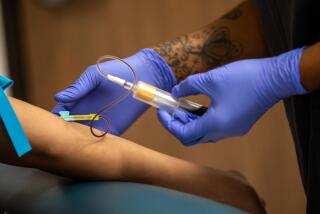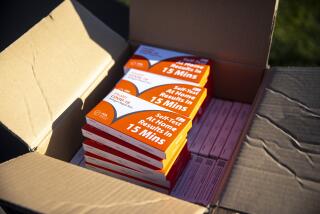Do-It-Yourself Health Tests: Over Time, Costs Will Soar
- Share via
No matter how tight-fisted Hillary Rodham Clinton’s health care policy committee wants to be, a new generation of low-cost medical technology is conspiring to drive up America’s health care costs by billions.
Sound paradoxical? Not at all. It’s just the expensively inevitable result of innovations designed to give more people more knowledge about their health.
Ever cheaper and more reliable medical diagnostics are increasingly finding their way into the home. When diagnostics for cancers, heart disease and the AIDS virus become as accessible and affordable as a bottle of aspirin--and they will--this country is going to see a multibillion-dollar explosion of demand for both medical attention and services.
Just this month, the Food and Drug Administration for the first time approved a home diagnostic for cholesterol: a prick-your-finger blood test that helps reveal your risk for clogged arteries.
“We have the technology to make a variety of (whole blood-based) tests available over the counter,” says Michael P. Allen, vice president of scientific affairs for Chemtrak, the creator of the CholesTrac home test. “Right now, the barriers are more regulatory than technical.”
Cheap at-home testing (and the earlier diagnosis that presumably will result) is of course a good thing. It will mean better health for millions of Americans. It will even save lives. From the standpoint of economics, averting illness and early death means more productivity from workers who might otherwise be lost to disease. And earlier diagnosis might save money on treatment later.
But new tests also mean new costs. People will learn things from home testing that will send them scurrying to doctors, and over the course of a lifetime they’ll consume more medical treatment. Those costs are right around the corner too.
Thomas M. Tsakeris, the FDA’s director of the division of clinical laboratory devices, which oversees home medical diagnostics, says: “There are many tests now available in physicians’ offices that could be done at home.”
Home pregnancy tests have grown into a nice little $200-million annual business. Perhaps home cholesterol tests will similarly blossom. But what happens to the health care system when cheap tests emerge that can reliably detect chronic or acute diseases?
Within three years, it’s technically possible that we could see a home diagnostic for prostate cancer, a disease that kills more than 35,000 men annually. Given that such high-profile personalities as the late Time Warner Chairman Steven Ross and Sen. Robert Dole (R-Kan.) have suffered this cancer, it’s highly likely that many men over the age of 40 will cheerfully spend $50 to $75 a year for a decent prostate-specific antigen test.
Similarly, what woman wouldn’t be prepared to spend a similar amount for a diagnostic that gave an early warning of ovarian cancer or breast cancer?
What happens if researchers discover a link between the level of a certain enzyme and the probability of a sudden heart attack? What 50-year-old male who has had one heart attack wouldn’t be willing to dip a piece of litmus paper into a toilet bowl every week to monitor that enzyme? Don’t you think there might be a demand out there for a home HIV diagnostic?
The more innovative and successful the home medical diagnostic industry becomes, the greater the demand for medical treatment. As these tests proliferate, there will be millions upon millions of what doctors call self-referrals. This surge of demand will add billions to the nation’s health care tab.
Alas, medical diagnostics--whether clinical or home--is seldom an exact science. “Irrespective of technology,” says the FDA’s Tsakeris, “there are very few tests that definitively identify or diagnose a disease or condition.”
For this reason--and an institutional reluctance to encourage patients to diagnose their own conditions--the FDA has traditionally taken a very cautious approach toward home diagnostics. But as the technology gets cheaper--and as Americans insist on greater knowledge and control over their health--a desire for reliable, low-cost, low-hassle diagnostics is emerging.
So where do we draw that predictive line? Suppose the prostate cancer test is accurate 80% of the time. It’s bad enough that the test will fail to detect the cancer in some men. But what about all those “false positives” that wrongly indicate the presence of cancer?
If 10 million men are doing home PSA tests twice a year and there is only a 10% false positive rate, that’s 2 million false alarms a year. As these tests proliferate, society could end up with tens of millions of false alarms battering our already over-stressed health care system.
“You might want to ask, for every 1% false positive, what’s the impact on the system?” Tsakeris asks. Suppose the accuracy rate is 85%? Or 75%? Is 75% accuracy acceptable for prostate cancer but not for HIV? At what level do you deny the public access to a test that could help save millions of lives? Do you trust the public to use these tests appropriately? Or should regulators take a more paternalistic approach?
Indeed, will the long-term benefits of early detection outweigh the short-term costs of increased demand for treatment?
“That’s a tough call,” Tsakeris says. “It’s at the very crux of the home test issue. How good should a home use test be in terms of the public health? We simply don’t have in place ways to determine public health outcome. For example, we don’t know at FDA if home use of the cholesterol test will have any impact relative to heart disease.”
As our population ages and becomes more susceptible to chronic disease, the home diagnostic issue becomes even more acute. Is it in the ultimate public interest to limit the diffusion of low-cost diagnostics? Or is the public welfare best served by encouraging people to test themselves early and often?
Any health care proposal that doesn’t begin to answer these questions may be making a very wrong diagnosis.






